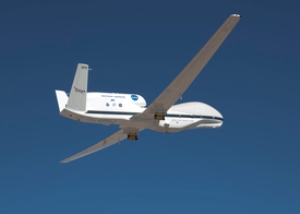Feb 8 2016
The NASA Global Hawk unmanned aircraft will carry out a number of assignments to gather thorough data over the Pacific Ocean from El Nino weather patterns. These complex weather patterns are the result of the differences between ocean temperatures all over the equator.
 The NASA Global Hawk unmanned aircraft will help scientists discover how El Nino affects weather patterns.
The NASA Global Hawk unmanned aircraft will help scientists discover how El Nino affects weather patterns.
As part of the missions led by the National Oceanic and Atmospheric Administration (NOAA), the Northrop Grumman Corporation-built (NYSE:NOC) NASA Global Hawk assignments have been scheduled from February to March. The multi-year assignments, known as Sensing Hazards with Operational Unmanned Technology (SHOUT), aim to provide in-depth meteorological measurements from an area in the Pacific that plays a vital role for interactions connected to West Coast rainfall and storms.
With the ability to fly at 65,000 feet for 30 hours, the NASA Global Hawk allows us to study intense and remote weather conditions that were previously unreachable.
Dave Aguinaldo, Program Manager, NASA Global Hawk, Northrop Grumman
Scientists from NOAA and NASA use the NASA Global Hawk, which helps to improve interpretation and forecast of winter storms, tropical storms, and very severe floods. The NASA Global Hawk is a long-endurance, unmanned, high-altitude aircraft, which collects data by operating with sea, land and air platforms. Scientists use the information gathered from this data to understand the influence of El Niño on the United States and as a result, NOAA's observational systems, predictions, and models can be further improved.
NASA and Northrop Grumman are partners under the Space Act Agreement, which permits shared use of the NASA Global Hawk unmanned aircraft to explore the possibilities of new missions, and carry out scientific experiments. Earlier missions conducted by NASA Global Hawk include hurricane research, which deals with analyzing the effects of greenhouse gasses and coordinating cutting-edge autonomous aerial refueling trials.